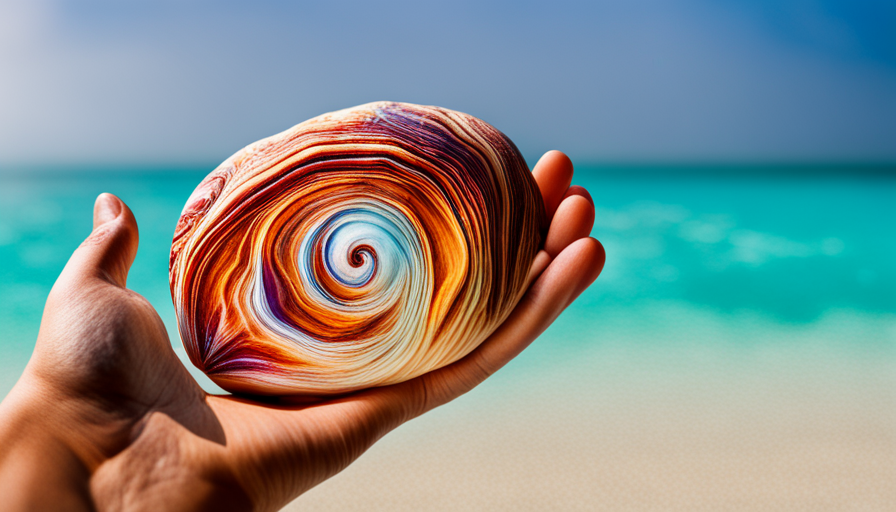Did you know that there are over 100,000 species of seashells in the world? That’s right, the ocean is teeming with these exquisite gems just waiting to be discovered on the beach.
If you’re someone who craves the freedom of exploring the shore and desires to find the best seashells, then this article is for you. In this guide, we will unveil seven techniques that will help you become a master seashell hunter.
Timing is everything, as the tides play a crucial role in revealing these oceanic treasures. By exploring different beaches and looking in the right places, you can increase your chances of finding rare and beautiful seashells.
Utilizing the ‘Shelling Stoop’ technique, bringing the right tools, and learning to identify seashells will enhance your success rate. Most importantly, we will emphasize the importance of respecting the environment and leaving no trace behind.
So, get ready to embark on an exciting seashell hunting adventure and uncover the mesmerizing beauty of these oceanic gems.
Key Takeaways
- Timing is crucial for finding the best seashells on the beach.
- Research tidal patterns and plan during low tide for optimal seashell hunting.
- Explore different beaches, especially less crowded and remote ones, for a greater abundance of seashells.
– Use the “Shelling Stoop” technique, bring essential tools, and learn to identify seashells to enhance the success rate of seashell hunting.
Timing is Everything

Timing is everything when it comes to finding the best seashells on the beach, so don’t miss out on the opportunity to uncover hidden treasures. To maximize your chances of finding the most exquisite seashells, it’s crucial to understand the importance of timing.
The best time to search for seashells is during low tides when the ocean recedes, revealing a wide expanse of the beach. During this period, the seashells that were once buried in the sand become exposed and easily accessible for collectors like yourself.
Tides and currents play a significant role in determining the availability and quality of seashells. As the tides change, the ocean currents carry shells from various locations, depositing them on the beach. This natural process constantly replenishes the seashell population, providing a fresh supply of treasures for you to discover.
It is essential to research the tidal patterns of the beach you plan to explore, as different beaches may have different optimal times for seashell hunting.
By understanding the best time to search for seashells and the role of tides and currents, you can increase your chances of finding the most coveted oceanic gems. So, seize the moment and head to the beach during low tides to embark on an exciting seashell hunting adventure.
The beach is waiting to unveil its hidden treasures, and with the right timing, you can be the fortunate collector who finds the most remarkable seashells.
Explore Different Beaches

When exploring different beaches for seashells, it’s advised to seek out less crowded areas. This will increase your chances of finding a wider variety of shells. Remote or undisturbed beaches often offer a greater abundance of seashells. This is because they have not been picked over by other beachgoers. By visiting these less frequented areas, you can increase your chances of discovering unique and pristine seashells for your collection.
Seek out Less Crowded Beaches
By heading to more secluded shores, you’ll stumble upon hidden treasures and pristine seashells that haven’t yet been discovered by the masses. Less crowded beaches provide an ideal environment for seashell hunting, ensuring a higher chance of finding rare and unique specimens.
To make the most of your search, consider the following techniques:
- Timing is key: Visit less crowded beaches during weekdays or early mornings to avoid the crowds and increase your chances of finding untouched seashells.
- Research local tides: Understanding the ebb and flow of the ocean will help you locate areas where seashells are likely to wash ashore.
- Look beyond the shoreline: Explore rocky areas, tidal pools, and offshore sandbars for hidden seashell treasures.
- Bring a scoop or shovel: Use these tools to carefully sift through the sand and uncover buried seashells without damaging them.
- Practice patience: Take your time and search methodically, as the best seashells may be buried or hidden among other debris.
By following these techniques, you can enjoy the freedom of discovering exquisite seashells on less crowded beaches.
Visit Remote or Undisturbed Areas
Exploring untouched and isolated locations allows for a more serene and immersive seashell hunting experience. When engaging in remote exploration, you have the opportunity to discover secluded destinations where seashells remain undisturbed and abundant.
These pristine areas are often far from the reach of bustling crowds, providing a sense of freedom and tranquility. As you venture into these remote locations, the absence of human interference allows seashells to grow and thrive undisturbed. The isolation of these areas creates a haven for a diverse range of seashells, increasing the chances of finding rare and unique specimens.
The beauty of visiting remote or undisturbed areas lies in the freedom to explore at your own pace, enjoying the serenity of nature and uncovering oceanic gems that will undoubtedly enrich your seashell collection.
Look in the Right Places

When searching for seashells on the beach, it’s important to look in the right places.
Begin your search along the water’s edge, where the waves deposit fresh shells with each tide.
Don’t forget to check under rocks and in tide pools, as these areas provide shelter for various marine organisms and can be a prime spot for finding unique seashells.
Search Along the Water’s Edge
As you stroll along the water’s edge, keep an eye out for hidden treasures in the form of seashells. This is where you’ll find the best specimens.
The constant ebb and flow of the waves brings shells from the depths of the ocean to shore, depositing them in a concentrated area. To make the most of your beachcombing experience, utilize techniques for finding seashells.
First, walk slowly and scan the sand for any signs of shells. Look for areas where the waves gently lap against the shore, as this is where shells tend to accumulate. Use your keen eye to spot the unique shapes and colors of seashells amidst the sand.
Remember to check the tide charts and plan your beachcombing adventure during low tide, when more of the beach is exposed and accessible. By following these tips for beachcombing, you’ll increase your chances of finding the most beautiful seashells along the water’s edge. Enjoy the freedom of exploration and let the ocean reveal its oceanic gems.
Check Under Rocks and in Tide Pools
While you’re strolling along the water’s edge, take a moment to lift up rocks and peer into tide pools, where a hidden world of marine life awaits your discovery. Timing is key when it comes to maximizing your findings, so consider these tips before starting your beachcombing adventure.
- Perfect timing: Plan your visit during low tide, when the water recedes, leaving behind an abundance of seashells and creatures exposed in tide pools.
- Observant eye: Look for rocks with crevices or clusters of seaweed, as these’re likely hiding spots for seashells.
- Gentle touch: Carefully lift rocks to avoid harming any marine life and avoid stepping on fragile tide pool ecosystems.
By following these beachcombing strategies, you’ll uncover a treasure trove of seashells and witness the intricate beauty of the underwater world. So, embrace the freedom to explore and enjoy the wonders that lie beneath the rocks and within the tide pools.
Use the “Shelling Stoop”

To perfect your technique for bending over, start by bending your knees slightly and keeping your back straight. This will ensure that you maintain a stable and balanced position while searching for seashells.
As you scan the sand and surface, pay close attention to any changes in color or texture, as these could indicate the presence of seashells. Be thorough in your search, moving slowly and methodically, and don’t forget to use your shelling stoop to get a closer look at potential finds.
Perfect Your Technique for Bending Over
Master the art of bending over and you’ll uncover the hidden treasures of seashells waiting to be discovered on the beach. Perfecting your technique for bending over is essential to avoid back strain and maximize your seashell hunting experience. Follow these steps to ensure you are bending over correctly:
| Step | Description |
|---|---|
| Stand with feet hip-width apart | Maintain a stable base for balance and support. |
| Engage your core | Keep your abdominal muscles tight to protect your back. |
| Hinge at the hips | Bend forward from the hips, keeping your back straight and neutral. |
| Bend your knees | Ensure your knees are slightly bent to reduce strain on your back. |
| Use your legs | Push through your legs as you rise back up, rather than your back. |
By perfecting your form and using these techniques, you can enjoy the freedom of exploring the beach for seashells without the worry of back strain. So, get out there and start bending over like a pro!
Scan the Sand and Surface
With a keen eye and a careful scan of the sandy surface, one can uncover a myriad of beautiful and unique treasures waiting to be discovered. To evoke an emotional response in the audience, consider the following nested bullet point list:
- The excitement of stumbling upon a perfectly intact seashell, its vibrant colors glistening under the sun.
- The joy of discovering a rare specimen, a treasure that few have laid eyes on.
- The satisfaction of knowing that each shell found is a small piece of the vast ocean, a reminder of the world’s endless wonders.
Using advanced scan techniques, such as dividing the beach into sections and methodically examining each area, one can maximize their chances of finding the most exquisite seashells. Surface exploration is key, as shells may be partially buried or hidden beneath layers of sand. By carefully combing through the sand, paying attention to texture and shape variations, one can uncover hidden gems that others might overlook.
So, take your time and immerse yourself in the freedom of discovering these oceanic treasures.
Bring the Right Tools

Don’t forget to pack your handy-dandy seashell detector when you hit the beach! Having the right tools is essential for finding the best seashells on the shore. With the right equipment, you can enhance your shelling experience and increase your chances of discovering oceanic gems.
To assist you in your seashell quest, here is a handy table describing the essential tools you should bring:
| Tool | Description |
| Metal Shovel | Use a metal shovel to dig in the sand and uncover buried seashells. It allows you to reach deeper layers and find hidden treasures. |
| Mesh Bag or Bucket | Carry a mesh bag or bucket to collect your seashell finds. The mesh material allows water and sand to drain, keeping your seashells clean and intact. |
| Magnifying Glass | A magnifying glass is helpful for examining intricate details of seashells. It allows you to appreciate the unique patterns and textures. |
| Waterproof Gloves | Protect your hands with waterproof gloves to avoid getting cut or injured while handling seashells. |
| Tweezers | Use tweezers to delicately pick up smaller seashells or remove debris stuck in larger ones. They provide precision and control. |
| Seashell Identification Guide | Bring a seashell identification guide to help you identify different species and understand their characteristics. |
By utilizing these tools, you can maximize your shelling experience and find the best seashells in your chosen shelling spots. Happy shelling!
Learn to Identify Seashells

Now that you’ve brought the right tools for seashell hunting, it’s time to delve into the fascinating world of seashell identification. Learning to identify seashells is essential if you want to find the best gems on the beach.
Here are some seashell identification tips and techniques to help you on your quest:
- Observe the shape: Pay attention to the overall shape of the seashell. Is it conical, spiral, or elongated? The shape can give you clues about the type of seashell you’ve found.
- Study the color and patterns: Examine the color and patterns on the seashell’s surface. Some seashells have distinct markings or vibrant colors that can aid in identification.
- Look for distinguishing features: Check for any unique features like spines, ridges, or knobs. These characteristics can be key in identifying specific seashell species.
- Compare with reference guides: Carry a seashell identification guide or use a reliable online resource to compare your findings. These references can provide valuable information about different seashell species and their characteristics.
By mastering these seashell identification techniques, you’ll unlock a world of oceanic gems waiting to be discovered. So, grab your tools, sharpen your observational skills, and embark on an exciting seashell hunting adventure!
Respect the Environment

When it comes to seashell collecting, it’s important to practice responsible behavior to protect the environment. You should leave living shells untouched, as these are important for the survival of the species and the overall health of the ecosystem.
Additionally, it’s crucial to avoid disturbing fragile ecosystems that seashells inhabit, as this can have a detrimental impact on their delicate balance.
Practice Responsible Shell Collecting
Practice responsible shell collecting by ensuring that you leave the beach with only memories and photographs, not a collection of seashells. It’s crucial to understand the environmental impact of shell collecting and strive for sustainable practices.
Here are two key ways to practice responsible shell collecting:
- Be mindful of the number of shells you collect: Limit yourself to a reasonable amount and prioritize quality over quantity. This ensures that enough shells are left behind for other beachgoers and maintains the ecological balance of the beach.
- Respect the natural habitat: Avoid disturbing live shells or any organisms that may be using the shells for protection or shelter. Leave shells that are inhabited by hermit crabs or other marine creatures in their natural habitat. Additionally, refrain from collecting shells from protected areas or fragile ecosystems.
By following these guidelines, you can enjoy the beauty of seashells while minimizing your impact on the environment.
Leave Living Shells and Fragile Ecosystems Undisturbed
Respect the delicate balance of the beach ecosystem and the homes of its inhabitants by leaving living shells undisturbed, allowing the beauty and wonder of nature to thrive undisturbed. When collecting seashells, it’s crucial to leave no trace and protect marine life.
Living shells play a vital role in the ecosystem, providing shelter and protection for various marine organisms. Removing them disrupts the natural balance and can have long-lasting effects on the entire beach ecosystem. By resisting the temptation to take living shells, you’re safeguarding the fragile habitats of countless creatures.
Remember, even the smallest disturbance can have a significant impact on the intricate web of life that exists beneath the waves. So, observe and appreciate the living shells from a distance, allowing them to fulfill their ecological roles undisturbed.
Frequently Asked Questions
How can I determine the best time of day to search for seashells on the beach?
The best time for a successful seashell search is during low tide when the shoreline is exposed, and the waves have receded. This allows you to access a larger area and increase your chances of finding a variety of seashells.
Are certain beaches more likely to have a greater variety of seashells?
Certain beaches, like hidden treasure troves, boast the best seashell hunting spots. Factors like water temperature, currents, and geological formations greatly influence the variety of seashells you’ll find. Explore and uncover the secrets of these bountiful shores.
What are some specific areas on the beach where I should focus my search for seashells?
To find the best seashells, focus your search on sandy areas near the water’s edge, where shells are more likely to wash up. Look for shell deposits, tide pools, and areas with rocks or seaweed, as these tend to attract a variety of seashells. Use a keen eye and patience for successful seashell hunting.
How do I properly use the ‘Shelling Stoop’ technique to find seashells?
To properly use the shelling stoop technique, position yourself near the shoreline, crouch down, and slowly sift through the sand. This method offers several benefits, including minimizing back strain and allowing for a more thorough search. Alternatively, you can try the shelling scoop or the shelling rake methods.
What are some essential tools I should bring with me when searching for seashells on the beach?
To optimize your seashell hunting experience, bring essential tools such as a shelling bag, shell identification guide, trowel, and a mesh sieve. Follow these tips for finding seashells on the beach to maximize your success.
Conclusion
Congratulations! You’ve now mastered the art of finding the best seashells on the beach. Timing, exploration, and knowing where to look have all become second nature to you. With your trusty ‘Shelling Stoop’ and the right tools in hand, you’re a force to be reckoned with.
Your ability to identify seashells has reached expert level, and you always remember to respect the environment.
So, go forth and conquer the beaches, my fellow seashell enthusiast. The oceanic gems await your discovery!

